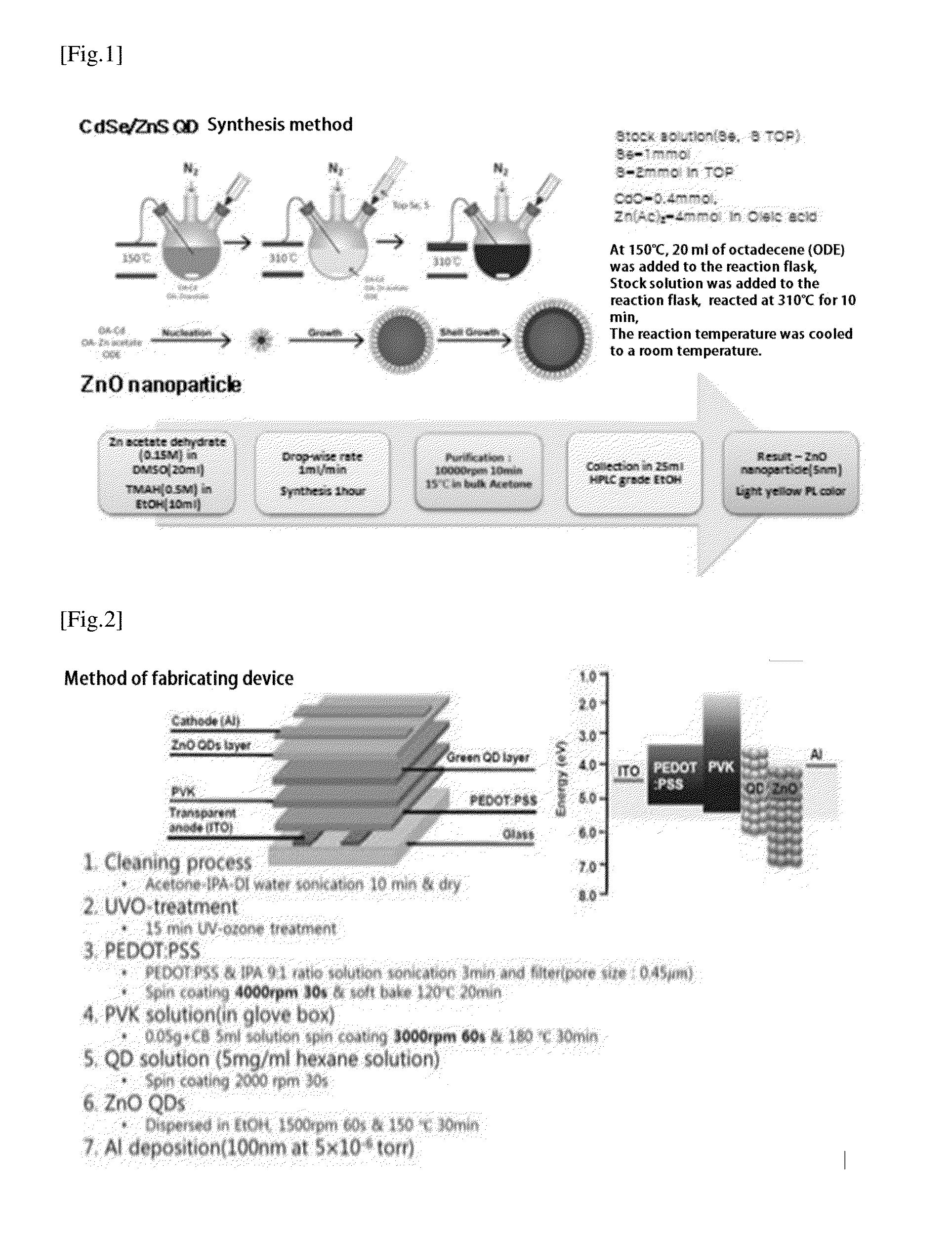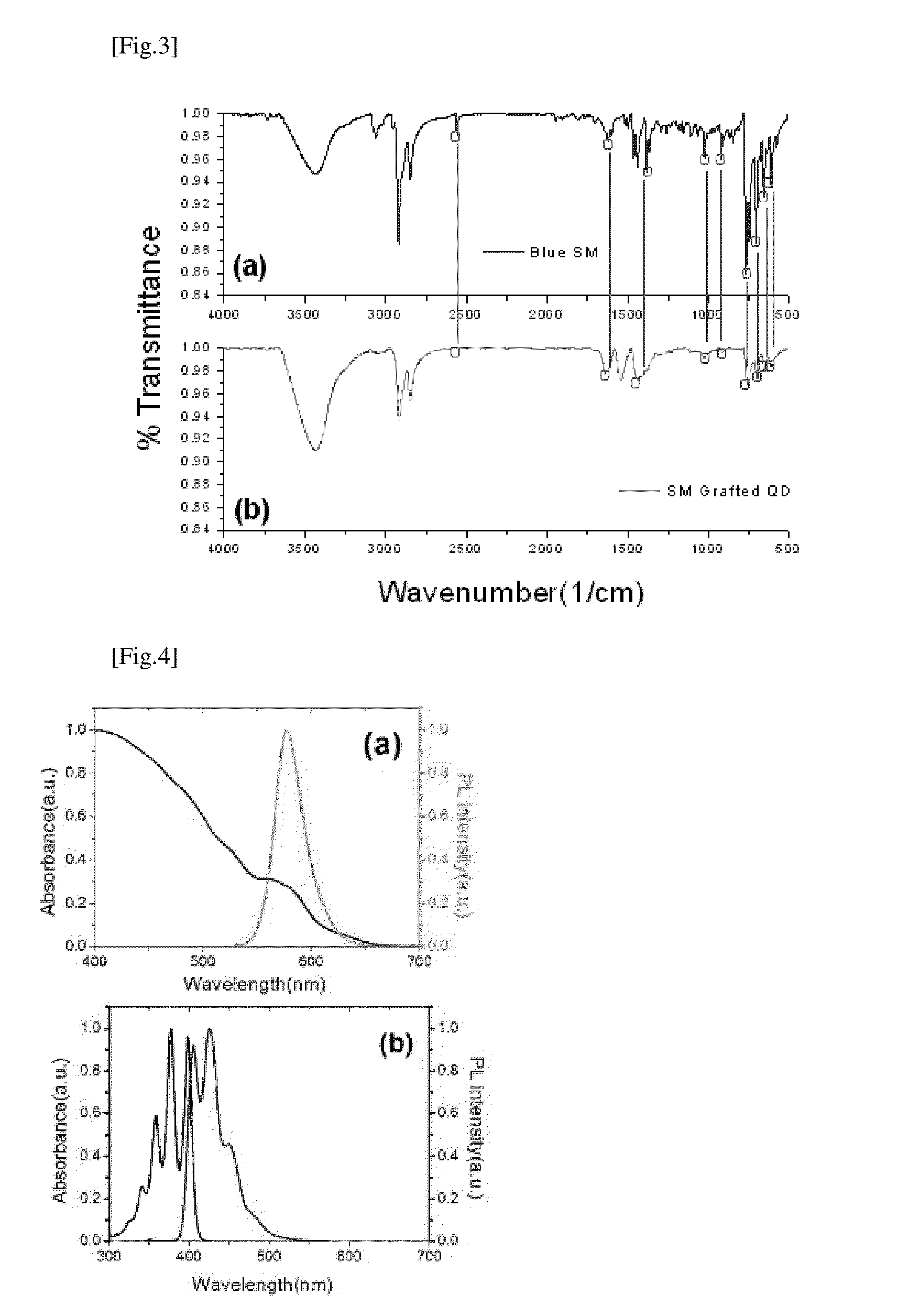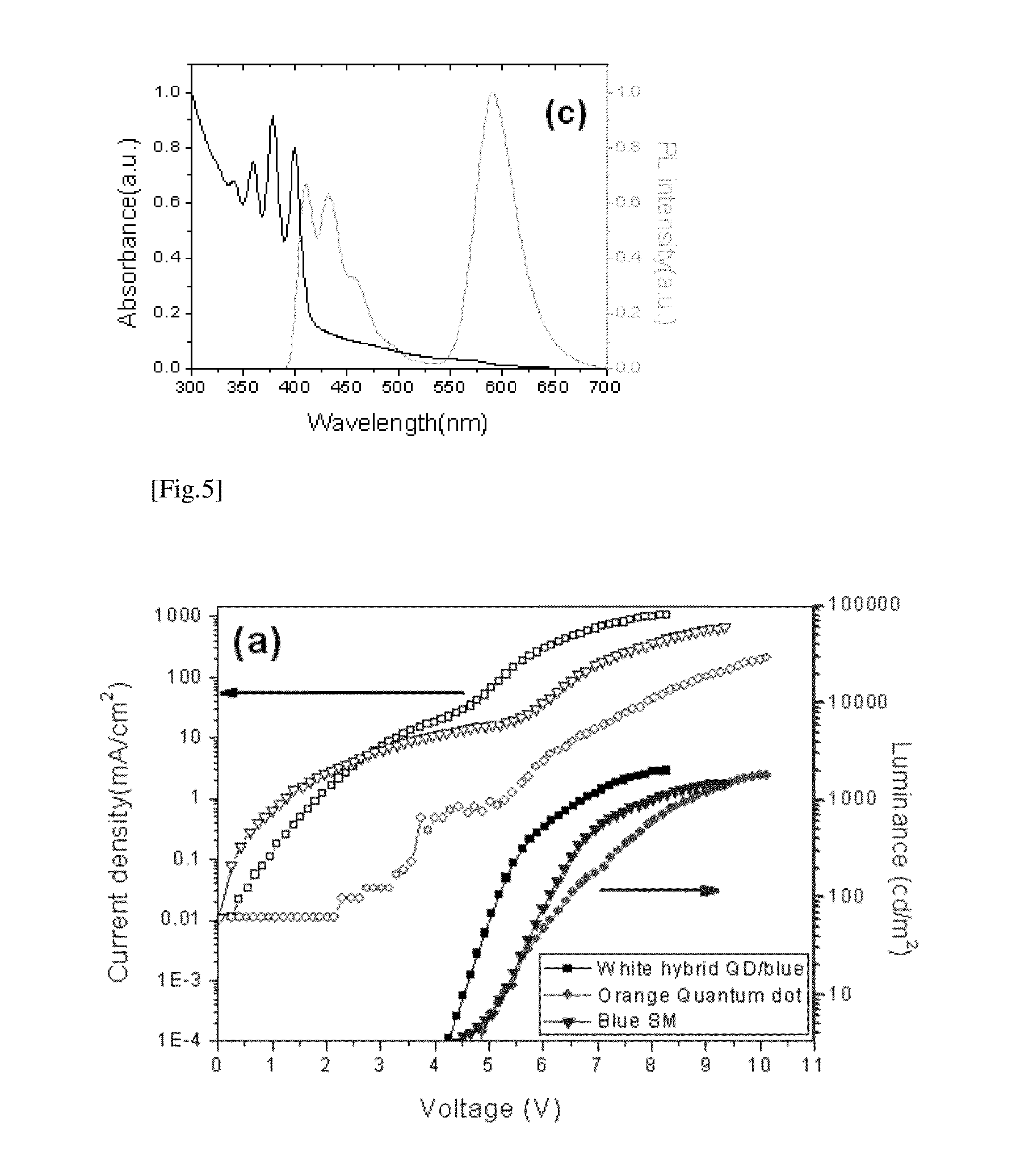Luminescent quantum dot
a quantum dot and light-emitting technology, applied in the field of light-emitting quantum dot, can solve the problems of poor dispersibility and stability, light-emitting devices, etc., and achieve the effects of excellent color purity, excellent dispersibility and stability, and excellent color purity and light-emitting properties
- Summary
- Abstract
- Description
- Claims
- Application Information
AI Technical Summary
Benefits of technology
Problems solved by technology
Method used
Image
Examples
synthesis example 1
Synthesis of 9-bromo-10-phenylanthracene (synthesis of light-emitting material)
[0046]Under an argon or nitrogen atmosphere, 4.2 g of 2-naphthalene boronic acid, 6.8 g of 9-bromoanthracene, 0.6 g of tetrakis(triphenylphosphine) palladium (0), 50 ml of toluene, and 8.4 g of sodium carbonate dissolved in 50 ml of water were added to a 250 ml flask and stirred for 24 hours while heating under reflux. After the reaction, it was cooled to a room temperature, and precipitated crystals were separated by filtration. The products were recrystallized from toluene, to give a crystal of 7.5 g.
[0047]Under an argon or nitrogen atmosphere, 7.5 g of the above crystal and 100 ml of dehydrated DMF (dimethylformamide) were added to a 250 ml flask, heated to 80° C. to dissolve the materials, and stirred for 2 hours after the addition of 4.8 g of N-bromo succinic acid imide at 50° C. After the completion of the reaction, the reaction solution was injected to 200 ml of purified water and precipitated crys...
synthesis example 2
9-(10-bromodecyl)-10-phenylanthracene (synthesis of spacer)
[0048]8 G of 9-bromo-10-phenylanthracene was dissolved in 300 ml of anhydrous diethyl ether. At 0° C., 18 ml of n-BuLi (2 M) was added slowly thereto. After the obtained mixture was kept at 0° C. for 1 hour, 21.6 ml of 1,10-dibromodecene was added thereto. After 30 minutes, the mixture was stirred for 2 hours under reflux. If the reaction was no longer occurring, the mixture was then cooled to a room temperature, followed by the addition of 80 ml of distilled water. The organic layer was collected and the water layer was extracted three times with 40 ml of ethyl ether. After water was eliminated with anhydrous magnesium sulfate, the products were separated by column using hexane as a mobile phase, to give 5.7 g (50%) of green oily phase 9-(10-bromodecyl)-10-phenyl anthracene.
[0049]1H NMR (CDCl3, 400 MHz): 8.32 (2H, d), 7.63 (2H, d), 7.59 (9H, m), 3.92 (2H, t), 3.65 (2H, t), 1.70-1.68 (2H, m), 1.64-1.60 (4H, m), 1.52 (10H, m)...
synthesis example 3
Synthesis of Compound DJ-A-1
[0050]4 G (1 eq) of 9-(10-bromodecyl)-10-phenylanthracene and 1.3 g (2 eq) of thiourea were dissolved in 50 ml of anhydrous ethanol and then stirred under reflux for 4 hours. 50 Ml of 6 M sodium hydroxide was added thereto and then stirred under reflux for 2 hours. If the reaction was no longer occurring, the obtained mixture was extracted three times with 30 ml of ethyl acetate after the elimination of ethanol. After the obtained mixture was washed with a brine solution and water was eliminated with anhydrous magnesium sulfate, the products were separated by column using CHCl3 as a mobile phase, to give 1.4 g (39%) of green oily phase 10-(10-phenylanthrace-9-yl)-decane-1-thiol.
[0051]1H-NMR (CDCl3, Varian 400 MHz): δ 1.26-1.38 (6H, m), 1.43-1.46 (4H, m), 1.62-1.66 (2H, m), 1.85-1.90 (4H, m), 3.42 (2H, t, J=6.8 Hz), 3.64-3.69 (2H, m), 7.31-7.35 (2H, m), 7.40-7.42 (2H, m), 7.48-7.59 (5H, m), 7.66 (2H, d, J=8.8 Hz), 8.33 (2H, d, J=9.2 Hz).
[0052]LC-MS (LC: Ag...
PUM
| Property | Measurement | Unit |
|---|---|---|
| diameter | aaaaa | aaaaa |
| temperature | aaaaa | aaaaa |
| diameter | aaaaa | aaaaa |
Abstract
Description
Claims
Application Information
 Login to View More
Login to View More - R&D
- Intellectual Property
- Life Sciences
- Materials
- Tech Scout
- Unparalleled Data Quality
- Higher Quality Content
- 60% Fewer Hallucinations
Browse by: Latest US Patents, China's latest patents, Technical Efficacy Thesaurus, Application Domain, Technology Topic, Popular Technical Reports.
© 2025 PatSnap. All rights reserved.Legal|Privacy policy|Modern Slavery Act Transparency Statement|Sitemap|About US| Contact US: help@patsnap.com



